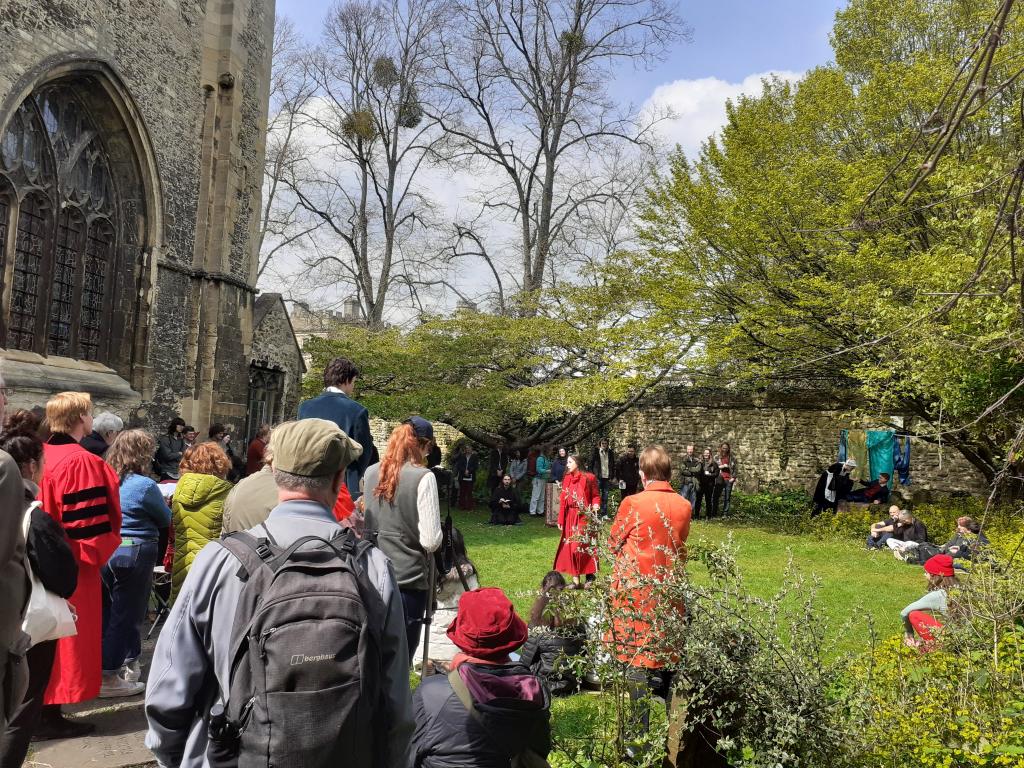
The Oxford Medieval Mystery Cycle on the 22nd of April brought with it a multilingual enchanting journey with eager participation from the audience! Now at its third reiteration, the event has become an Oxford tradition and a valuable highlight of the TORCH Humanities and Oxford Medieval Studies calendar, with the support of the Medieval and Modern Languages Faculty and the History Faculty. The fantastic academic and public engagement event was open, as always, to everyone. It offered a variety of plays in different medieval and modern languages, dating from the twelfth to the sixteenth century and was staged at several stations in the beautiful grounds of St Edmund Hall. Part of the charm of the Medieval Mystery plays was that they were performed with the audience—duly invited to participate—sitting around the different acting stalls of the space at St Edmund’s Hall.
Our performance was created with the Sorores Sanctae Hildae (unter Beteiligung einiger Bauern aus Iftelei), and directed by Emeritus Professor of Drama, David Wiles. The text of the play we worked on originates in twelfth century Bavaria. Written in both Latin and German, it is part of the Ludus de Passione (‘Play about the Passion’), discovered in the Carmina Burana manuscript. Passion Plays were written and performed throughout Western Europe in both Latin and vernacular languages during Lent and Holy Week. They vary in style and structure, but all focus on events which occurred in the final week of the life of Jesus of Nazareth, including his arrest, trial, and execution by crucifixion. The recourse to daily language, spoken by everyone, attests to the realistic dimension carried by these plays. Importantly, the representation of the story of the Passion of Christ through artistic performance renders their meaning accessible to most people in the audience, regardless of the language of the plays of the cycle. They were a popular form of entertainment in the Middle Ages and the aim of reviving the plays in the medieval setting of St Edmund’s Hall was to create a dramatic moment in which audience and actors alike could play a part in creating a spectacle that unfolded throughout the day.
The costumes for our play were chosen to be conspicuously timeless yet modern, with elements of colour coding, playing on their respective symbolism, as a deliberate visual tactic. The back of the churchyard around St Peter-in-the-East which served as the stage brought with it a spectacular momentum: the audience was seated or standing around the different stalls, next to the merchant offering them cosmetics, behind the Devil tempting them, or being offered weapons by Judas on their way to Gethsemane, and no one escaped the contagious dance of Mary Magdalen’s song of worldly pleasures.

The presence and participation of the audience really made it feel like we were creating the spectacle together. The fact that we could sing, occupy the space, and move around the members of the public made it a memorable experience. Our play favored the ‘up close and personal’ view whenever appropriate and possible within space, with a strong endeavour to capture real-life approaches to human suffering.
The juxtaposition of the two Maries is a striking feature of the play from which our extract is taken, with their lament at the foot of the cross alongside other weeping women. The personae of Mary Magdalene and the Virgin Mary are charged with powerful emotions of a particular kind, partly due to their femininity and representation as inspirational women that figure in the literature, visual art, and music of Western culture. Mary, the mother of Jesus, is given a resounding planctus (‘sorrow’) monologue at the end of the play as, supported by John, Mary Magdalene, she and the audience contemplate the spectacle of the murdered Christ following Joseph on their procession.
The element of the Passion tradition, the Hanging of Judas, constructed in symmetry with the Crucifixion, was equally a crucial moment. Including an enterprising merchant scene was an engaging way to involve the audience, but equally enabled the imaginative treatment of Mary Magdalen. The audience saw Mary's life in sin, her buying cosmetics, and her struggle with the counsels of the angel and the devil. Her purchasing of the most expensive ointment from the merchant to anoint Christ’s feet is a transformed version of her buying rouge and perfume at the beginning of the play. Her lament and suffering as she anoints Christ’s feet was particularly emotional.
The popular image of Mary Magdalen and her place in medieval literature, music and visual art oscillates between that of a passionate woman openly choosing the pleasures of life and that of a repentant sinner. Her quest for ultimate love is extremely powerful, as she contains within her persona the elements of sensuality and abandonment, earthly joys, and divine transcendence all at once.
The extensive use of the German vernacular by the author, added dramatic tension and relevance and we tried to convey all these aspects to our modern audience. Getting into the character of Mary Magdalen, who constantly switches from singing (‘Young man, let me please you’ in the Carmina Burana Passion Play) and speaking in Latin, to addressing the audience in German, whilst going through the different passionate states of her persona, was a very exciting project for me to work on as a linguist. The complexity of her character can only be grasped once there is a deeper understanding of her representation as a victim of evil companionship, but also as a woman whose quest for boundless love was deeply powerful. Within her story, that of an imperfect human being who nonetheless draws close to God and becomes his disciple, the audience found a profound echo of the deepest human aspirations and emotions.
Our performance can be seen again at the Oxford Festival of the Arts on 16th of July… and stay tuned for the fourth reiteration of the Oxford Medieval Mystery Cycle in April 2024!